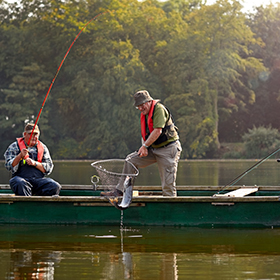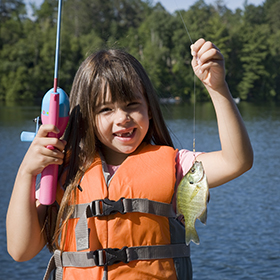Fall means changes in fish behavior and techniques. And one of the most anticipated fall fishing activities is the migration of steelhead.
Fall is a period of transition. Changes in temperature, changes in vegetation, changes in fish behavior. The cooler temperatures trigger some different fish feeding patterns and movements. One of these eagerly anticipated movements is the annual steelhead migration.
Genetically, steelhead are rainbow trout, however they are anadromous which means they travel back and forth between streams and large lakes or the ocean. In my neck of the woods, steelhead now are pushing up tributaries of Lake Erie. This means my son and I try to squeeze in as many 1 ½ hour treks up there as conditions and fishing windows allow. I’d love to take my daughter too but she refuses to get up at 3:00 a.m., no matter how great the fishing.
There are several techniques for fishing for steelhead, depending on the stream conditions, temperature, and angler preference. On our last trip, we employed our preferred method: casting spoons into the lake near the mouth of one of these tributaries. In fact, we love this way so much, if conditions don’t let us cast spoons (murky lake, stream runoff too high, etc.) we often choose to chase other species elsewhere.
We made three steelhead trips last year, about 21 combined angler hours of effort, and didn’t land a fish. Perhaps we could have employed other techniques but we continued to chuck our spoons, believing that at any minute, a large steelhead would hammer our offering.
Why do we insist on this method? Well, there are little things like just the casting. There is a peaceful rhythm from launching long casts and the resulting long retrieves. Plus, we usually have a little bit more elbow room than fishing upstream. And the scenery is nice too when standing in one of the largest freshwater lakes. After wading into the lake in the dark on our last trip, my son counted 21 shooting stars before sunrise.
And there are big things, like the hit. Unbelievable. The following fight is great too, don’t get me wrong, but the sudden transition from feeling a pleasant, peaceful little wobble during retrieval to the nerve-rattling jarring from a solid smack and then something large and fast trying to yank the rod from your hands, testing the extreme mechanics of the drag of your reel, leaping in the distance, “heading to Canada”… is tough to compete with.This method is so exhilarating that sometimes, I admit, we may be in a bit of a stubborn, self-imposed rut, passing up fish that could be caught with other techniques. But when it works, when the pieces come together, that “rut” morphs to a “groove,” resulting in sore arms and anglers, which for the next few days, may not be completely responsive, with mouths slightly agape, staring off into the distance.
A couple of other methods were employed near us during our last trek. The couple to our left were bait anglers. They would just cast out a bit of skein (fish egg sac) and let it rest on or near the bottom. The bite is more subtle as the fish mouths the bait and then moves off. These anglers are in it mostly for the fight. They were hooking up regularly, snapping photos, and then releasing their shiny catch.
To my right was a fly fisherman. Normally this time of year, he’d be in the stream but low water had the fish (and many of the anglers) concentrated at the mouth, unable to work upstream except during a few meager rain events.
Sometimes there can be issues when different techniques are employed side by side. However, some fish were caught near shore so this angler didn’t need to cast more than a rod length or two into the lake. His small nymph pattern fly was suspended near the bottom under a tiny fuzzy bobber, er, I mean “strike indicator” in a slight current that pushed it directly out into the lake, rather than the potential space complication of a side current. He missed his only hit in 4 hours. But he wasn’t there for the hit; he was using this fly fishing method because he wanted to feel the line rip through his fingers. He was the angler in a rut now, unable or unwilling to switch techniques. In December however, with some rain, he’ll be upstream in a “groove.
Even if the spoon bite is “on,” there are several factors to keep in mind:1. Size
We usually cast 1/3 oz. But may adjust a size up or down until we find what the steelhead want.2. Color
If you notice another angler hooking up many more types than you, see if you can notice the color (and size while you’re at it) of that spoon. As the light intensity grows throughout the morning, the “hot” color often changes.3. Type
Not all spoons are alike. Some ride higher in the water column. Some cast further. Some flutter a little wider. My son and I each carry a small box with an assortment of sizes, colors, and types, rarely casting the exact same lures until we have really dialed in the pattern.4. Position
Sometimes the fish strike right as you lift the spoon out of the water. Did that fish follow the lure in, or do you need to back up because you may be standing in or near the preferred steelhead channel? Or are they holding closer to that steep drop off near the gravel bar?5. Leader
Many spoon anglers have a length of light line tied to a swivel or snap & swivel. The belief is that the lighter line is less apt to be seen and thus the rate of hook ups increased. However, this addition can lead to more lost fish when the line or extra knots break. Guess I’ll just have to continue my “research” on this technique.Whatever method you prefer, you may want to check a map to see if steelhead are within driving range. And check the regulations. Steelhead fishing may require an additional fee and stamp on your fishing license. Don’t expect to hook up the first trip; it may take some time to learn where to be, what to cast, and when. Anglers of Erie tributaries average about 1 fish every 3 hours. But just watching (or trying to photograph) the leaping acrobatics of these fish and hearing the screaming reel of a lucky angler may be worth the trip.









